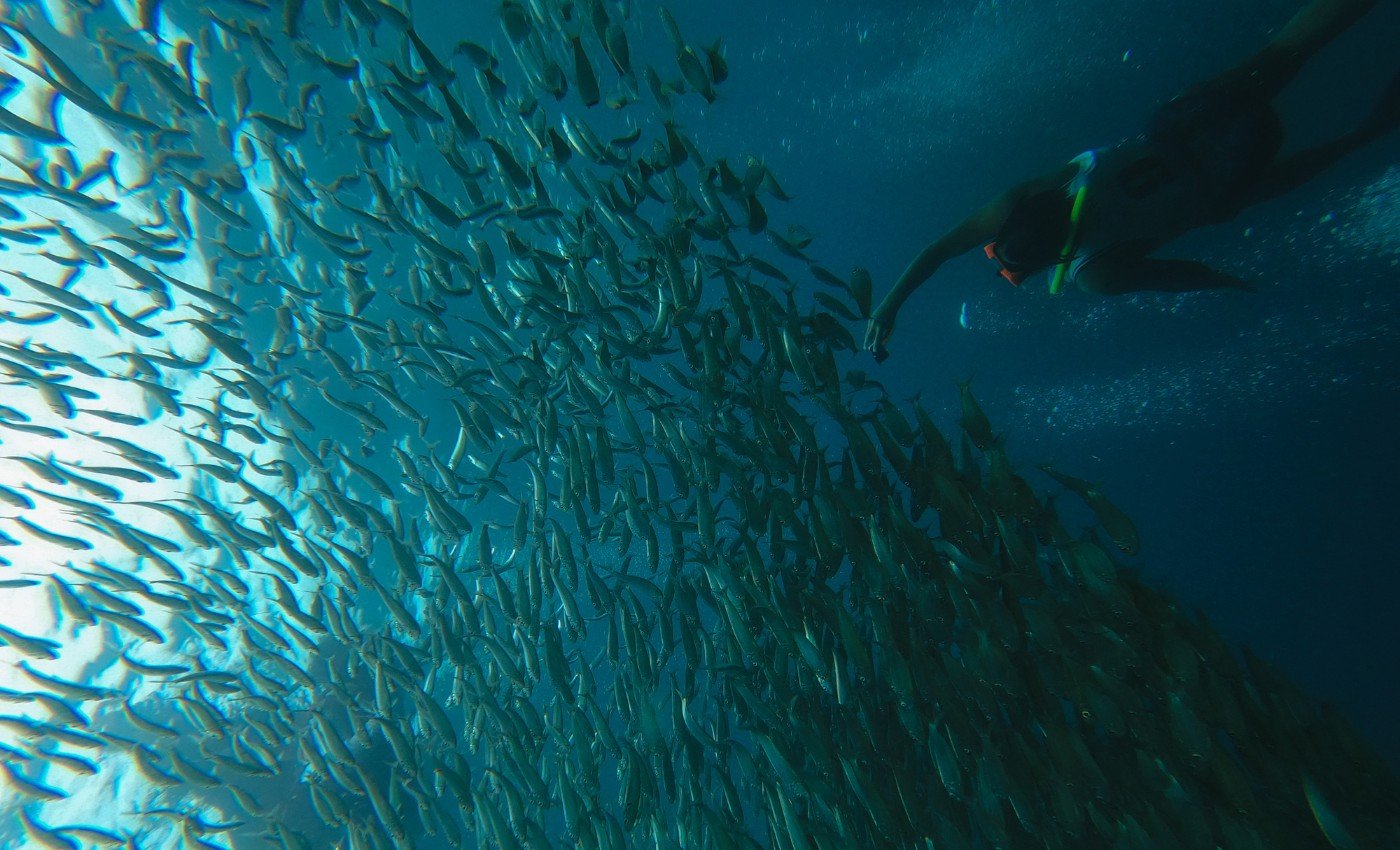
Moalboal Sardine Run: Amazing (and Ethical) Philippine Adventure
Ever since I was a kid glued to the Discovery Channel, I’ve had this oddly specific dream: to be swallowed by a shimmering cloud of fish, moving like one living, shape-shifting creature. Not to eat them (promise), but to float in their silver storm, feeling the ocean’s heartbeat through a million flickers of light.
Turns out, that dream lives in Moalboal, a small coastal town in the Philippines famous for its sardine run. Unlike South Africa’s migrating sardines, here they stay all year—just a few metres from shore.
The best part? You don’t need a tour, a boat, or even scuba gear. Grab a snorkel, wade into the water, and you’re in the middle of one of the ocean’s greatest spectacles.
In this post, I’ll share everything you need to know about the Moalboal sardine run—when to go, how to get there, what to expect, and why this is one of the most ethical wildlife encounters in the Philippines.
This post contains affiliate links. If you make a purchase through these, I may earn a small commission at no extra cost to you, which helps me keep this blog running. Thanks for your support 🙂
🐟The Moalboal Sardine Run in a Nutshell🐟
Table of Contents
ToggleWhere is Moalboal and Why is it Famous?
Located on the southwestern coast of Cebu Island, about 90 kilometres from Cebu City, Moalboal is a tropical gem that draws travellers from all over the world. With its vibrant coral reefs, laid-back beach vibe, and incredible marine life, it’s a paradise for snorkellers and divers alike. But the true highlight of the region are the legendary Moalboal sardines — millions of shimmering fish that swirl together in massive, glittering formations just a few metres from the shore. Watching this living cloud of sardines is nothing short of magical, and it’s an experience you won’t forget.
The Sardine Run Phenomenon Explained
How Millions of Sardines Move in Perfect Synchrony
Sardines form massive schools to protect themselves from predators like trevally, mackerel, and even reef sharks. A lone sardine is an easy snack, but a swirling mass of thousands? That’s a predator’s nightmare! The tight formations and rapid direction changes make it hard for hunters to single out one fish, creating a “confusion effect.” Plus, more eyes mean better predator detection—it’s like having a million security cameras!
So.. how do Moalboal sardines move in perfect synchrony? They’ve got a sensory organ called the lateral line, which detects tiny changes in water pressure and movement, letting each fish sense its neighbors’ actions instantly. When one sardine twitches, the whole school reacts in a split second, creating those hypnotic waves and swirls. It’s like they’re all connected by an invisible Wi-Fi network!
Why Moalboal is the Perfect Spot for This Event
Most sardine runs, like the famous one in South Africa, are seasonal and unpredictable. But in Moalboal, things are different. Thanks to the nutrient-rich waters off Panagsama Beach, the sardines stay put all year round. That means no matter when you visit, you’ve got front-row tickets to this natural wonder.
What makes it even more special is how ethical the experience is. Unlike many wildlife encounters that rely on feeding or chasing, here you simply swim alongside the sardines on their own terms. They’re free to move as they please, commercial fishing is banned, and your presence leaves little to no impact on their behaviour or habitat.
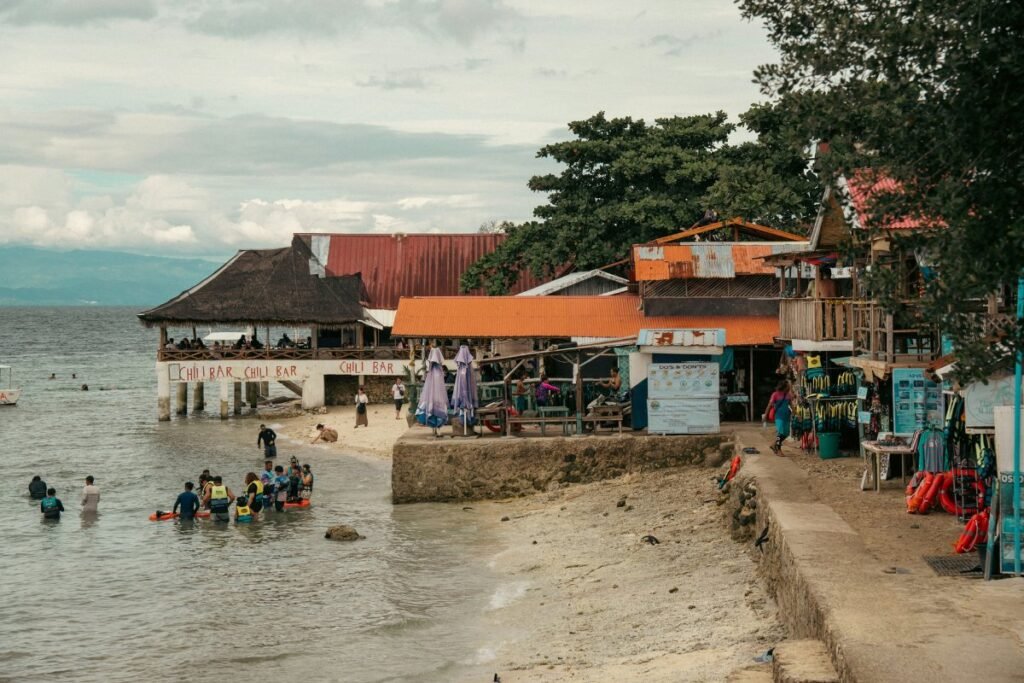
Where Exactly is the Sardine Run in Moalboal?
The Moalboal sardine run takes place just off Panagsama Beach, where massive schools gather along the reef wall only a short swim from shore. Forget about long boat rides or expensive tours—this natural wonder is literally a few steps from the sand, making it one of the most accessible marine spectacles in the world.
Most of the action happens about 20–30 metres out, where the reef drops from shallow water into deeper blue. The sardines shift and swirl here in their thousands, creating a living curtain of silver that you can swim straight through.
The best part? Conditions are usually calm with no big waves or strong currents, making it a beginner-friendly adventure for swimmers and snorkellers of all levels.
Here’s the exact spot where you’ll want to head into the water:
Best Time to Visit Moalboal (and the Sardines)
The Moalboal Sardine Run off Panagsama Beach is a year-round marvel, but timing matters for the best experience. November to May (dry season) offers crystal-clear waters (20-30m visibility), sunny skies, and calm seas, perfect for vivid sardine displays, though it’s peak season, so book early. The wet season (May-October) has decent conditions but lower visibility (10-20m) and occasional showers.
I visited in January, and while I didn’t score endless sunshine, the visibility was still decent, even on cloudy days I managed to snap some pretty great photos.
The time of day also matters. Midday (10 am–2 pm) offers sunlight that makes the sardines glitter like a giant underwater disco ball. But it’s also the busiest time, with guides towing non-swimmers around and plenty of elbows competing for that perfect shot. My favourite? Sunrise. We hit the water at around 6 am, and for about 15 magical minutes, we were literally the only people in the water, it felt like the entire ocean belonged to us. The sardines were even closer to shore—just 15–20 m out—making it the perfect crowd-free swim.
For the ultimate experience, do both: one midday swim for the sparkle, and one sunrise swim for the serenity.
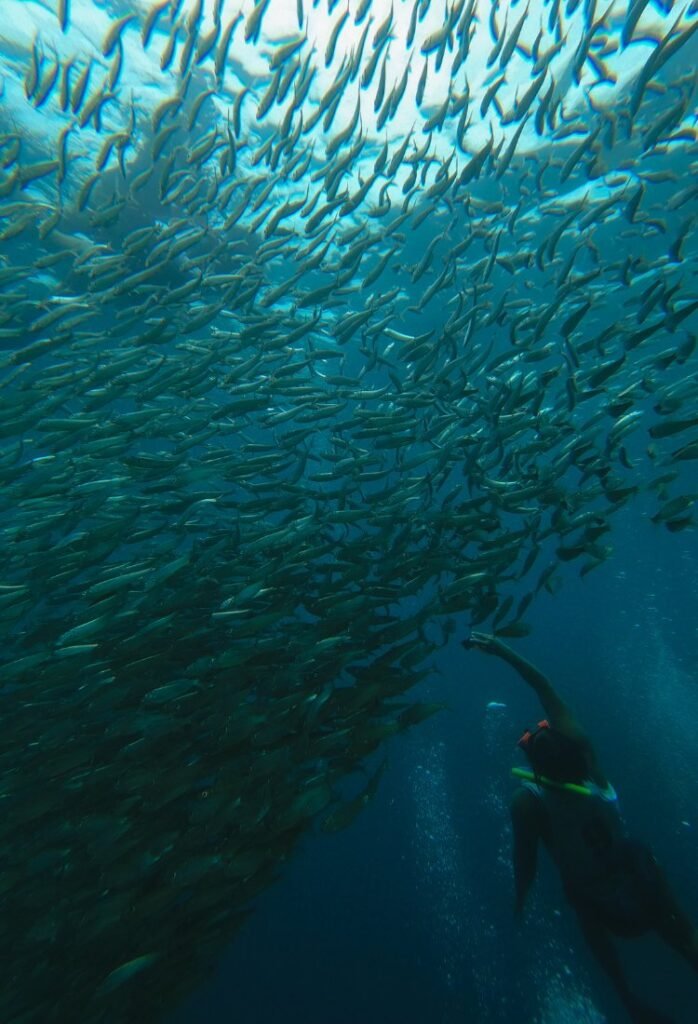
How to Get from Cebu City to Moalboal
Getting from Cebu City to Moalboal is actually pretty straightforward. The town sits just a few hours south, and you’ve got two main ways of reaching it, depending on your budget and patience:
By Bus (budget-friendly but slow)
If you’re not in a rush and don’t mind a bit of organised chaos, the Ceres Bus from Cebu South Bus Terminal is the cheapest way to go. A ticket for the air-conditioned bus costs around PHP 200–210 (about USD 3.50), and the journey usually takes 3–4 hours. It’s a popular option, so expect a crowded terminal, a bit of pushing and shoving as people scramble to board, and a bus packed with both locals and tourists. Just make sure you hop on the service heading straight to Moalboal and not the one via Oslob, as that detour will add even more time.
By Taxi (fast, direct, and comfortable)
If the thought of waiting in line at the bus terminal under the Cebu heat doesn’t sound appealing, then taking a taxi is your best bet. It’s definitely pricier, but the payoff is a direct, air-conditioned ride that drops you right at your hotel or Panagsama Beach, where the sardine run happens.
I actually started my journey with the intention of catching the bus, but after waiting around in the crowded terminal for a while, I decided to team up with three other backpackers I’d just met, and we decided to split the cost of a taxi. It set us back around PHP 3,500 in total (roughly USD 20 each), and the drive took just 2.5 hours. Honestly, it was the best decision—we avoided the hassle and arrived in Moalboal relaxed and ready to hit the water.
Do You Need a Tour to Experience the Moalboal Sardine Run?
The beauty of Moalboal’s sardine run is that you don’t need a tour. Just swim 20–30 metres out from Panagsama Beach and you’re in the middle of it. It’s one of the rare natural spectacles you can enjoy completely independently.
That said, there are two situations where booking a tour makes sense:
- If you’re not a confident swimmer. Even though the water is calm with no currents, some people feel safer with a guide, which is totally understandable.
- If you want epic underwater photos. Sure, a friend can press the button on your GoPro, but the best shots—the ones where the sardines swirl around you in cinematic fashion—usually require the camera to be level with, or even below, the subject. A guide who knows the tricks can make that happen.
If you do hire a guide, look for bundle deals that include snorkelling gear rental. It often works out cheaper than paying for everything separately. Tours can be booked online or at the shops along Panagsama Beach.
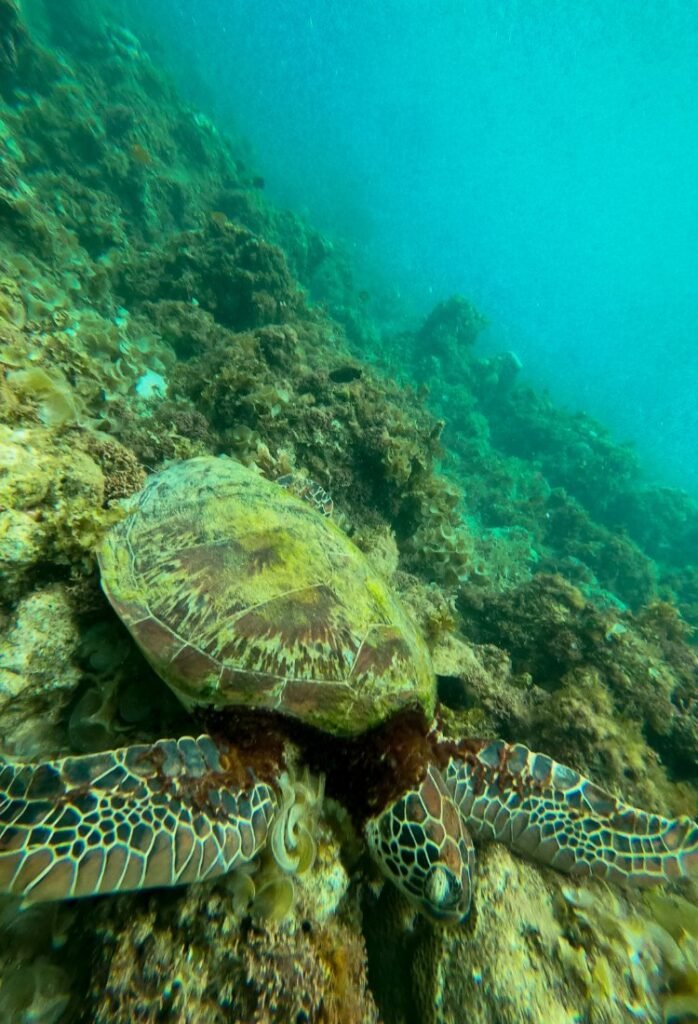
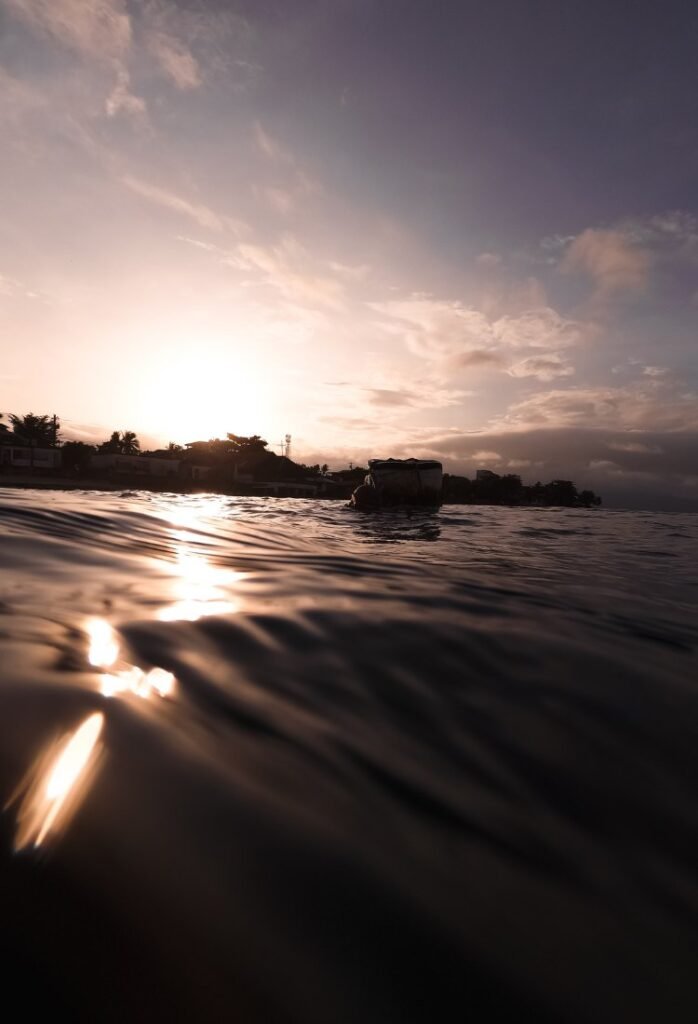
Is There an Entrance Fee?
The only charge associated with the Moalboal sardine run is an environmental fee charged by the municipality, payable at a booth near the shore or the Moalboal Tourism Office. I was advised this fee supports marine conservation and is around 2 USD. Make sure that you keep a copy of your fee receipt so that you can present it if you are asked.
Where to Rent Snorkel, Mask and Fins in Moalboal?
If you don’t have your own gear, no worries—Panagsama Beach has you covered. Along the main strip, dive shops and small stalls rent out snorkelling gear. Some shops even let us stash our bags for free in their lockers, which was super handy for keeping towels, shoes, and wallets safe while we swam.
GoPro rentals are also available, and if you’re keen on professional-looking shots, you can hire a guide to swim with you and take underwater photos for an extra fee.
Here’s a rough breakdown of rental prices if you’re hiring gear independently:
- Mask + Snorkel: 100–300 PHP ($2–$6 USD) per day
- Fins: 150–300 PHP ($3–$6 USD) per day (short fins are cheaper, long fins cost more)
- Life Vest: 100–200 PHP ($2–$4 USD) per day, though often included in tour packages

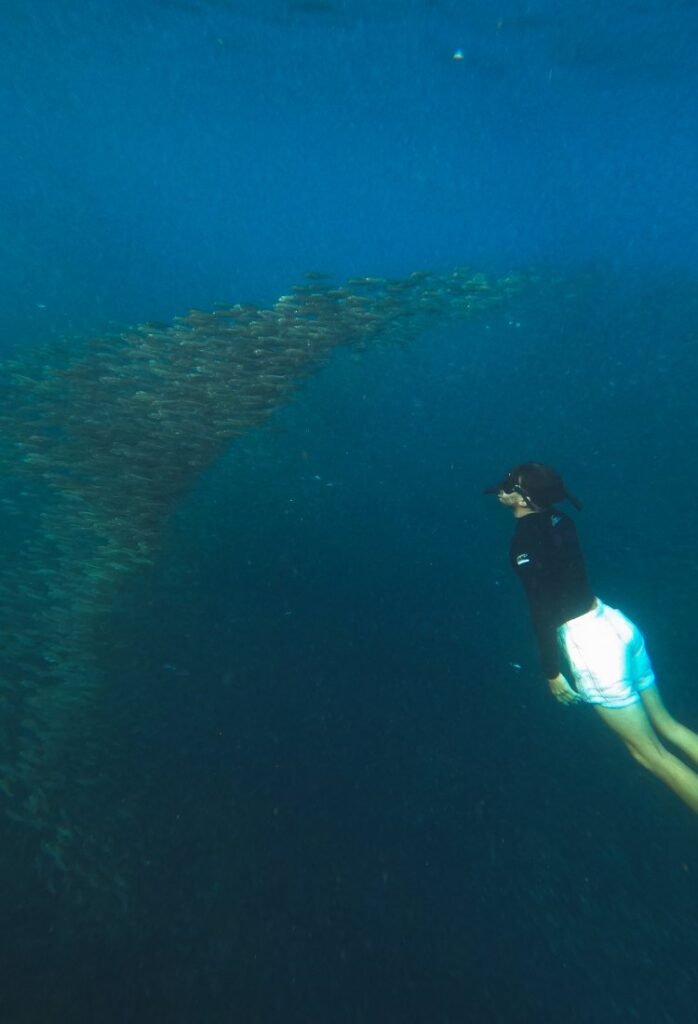
Where to Stay in Moalboal?
Moalboal has plenty of accommodation options, from budget-friendly hostels to cosy guesthouses and beachfront resorts. If you’re here mainly for the sardine run (and let’s be honest, you probably are), location is everything. Staying near Panagsama Beach means you can roll out of bed and into the ocean for an early-morning swim with the sardines—no tricycles, no stress, just convenience. Plus, the area has a great mix of cafes, bars, and restaurants, so you’ll never go hungry.
Here are my top picks depending on your budget:
Budget: D´Gecko Hotel
Mid-range: Tipolo Beach Resort
Higher-end (but still affordable): Secret Paradise Moalboal
Is it Ethical To Swim with the Moalboal Sardines?
Yes, the sardine run is one of the most ethical wildlife encounters in the Philippines. Moalboal sardines gather naturally without feeding, chasing, or artificial lures, and commercial net fishing is banned. They’re free to come and go as they please.
Still, responsible behaviour is crucial: don’t touch or chase the sardines, and always use reef-safe sunscreen to protect the fragile marine ecosystem. The government supports this balance by banning net fishing and allowing only small-scale, traditional methods for personal consumption.
Final Thoughts
The Moalboal sardine run isn’t just an underwater adventure, it’s a vivid reminder of how beautiful and fragile our oceans are. It doesn’t matter whether you’re a seasoned diver or a first-time snorkeler, drifting among millions of shimmering sardines is a surreal, once-in-a-lifetime experience that deserves a spot on every traveller’s bucket list.
What makes it even more special is how ethical and low-impact it is: you’re witnessing one of nature’s greatest spectacles exactly as it happens, without disturbing the animals or their environment.



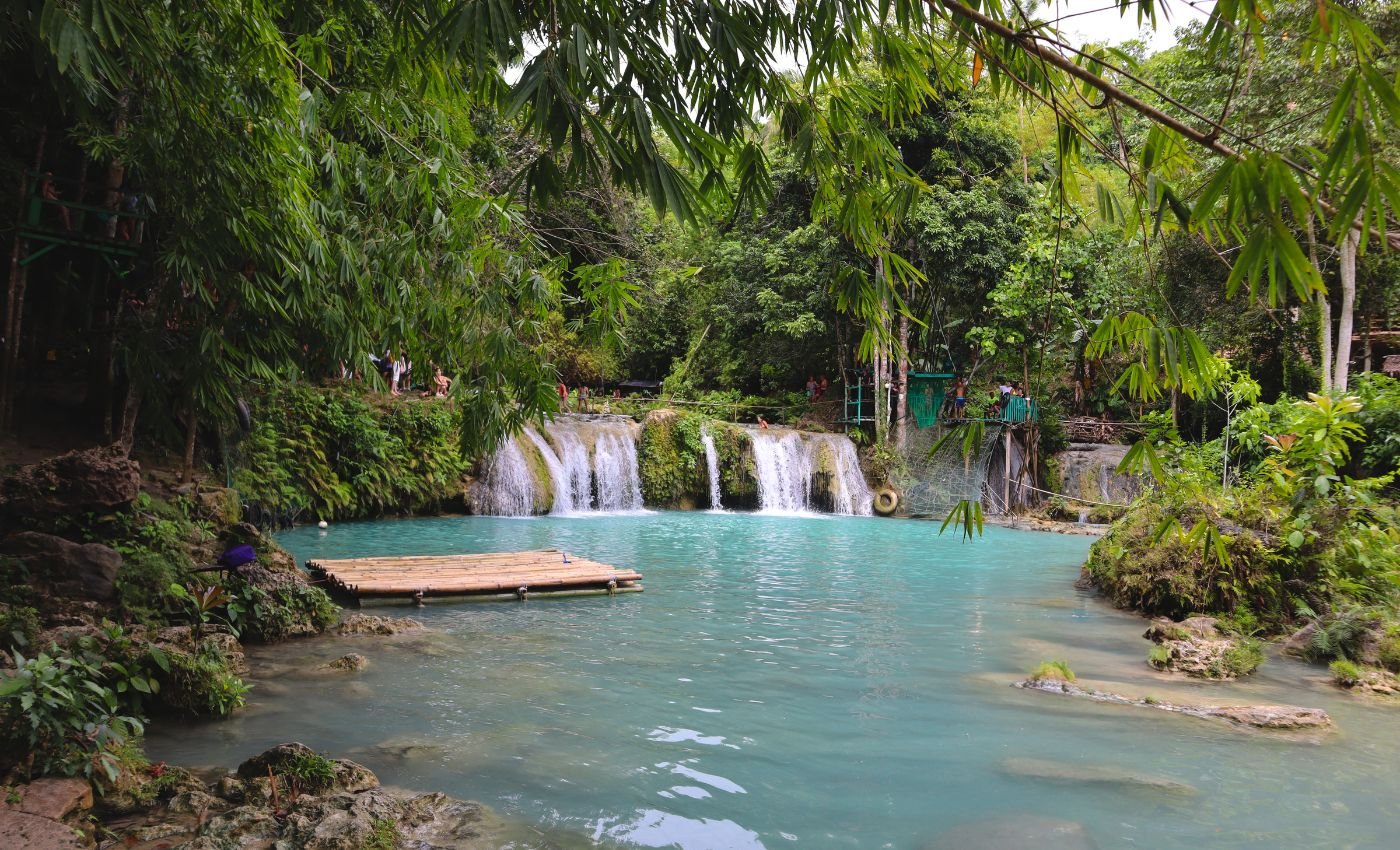
Leave a Reply